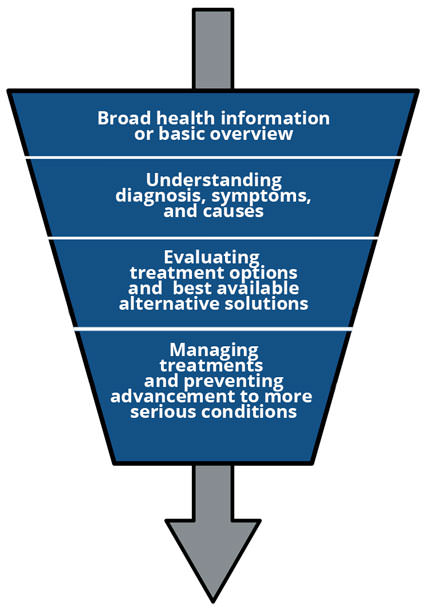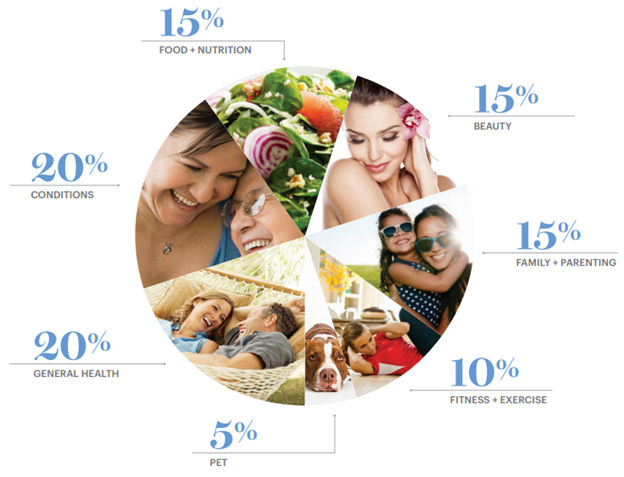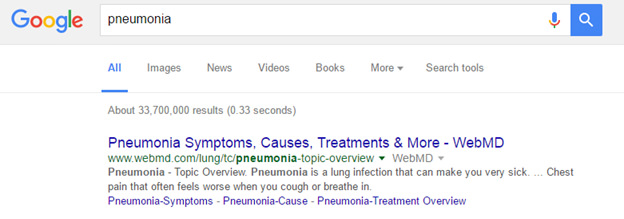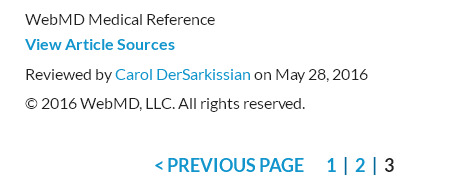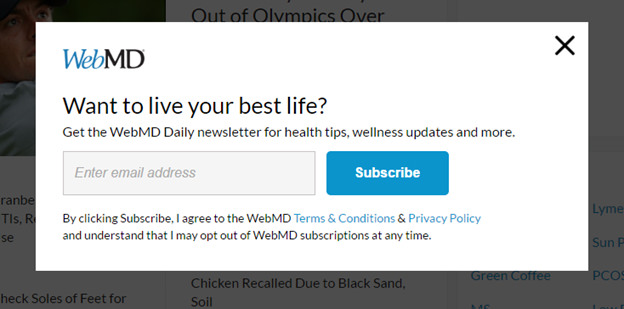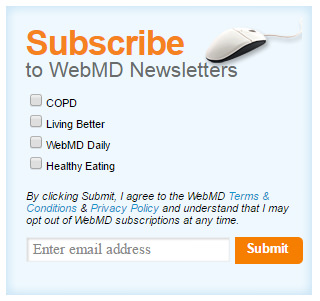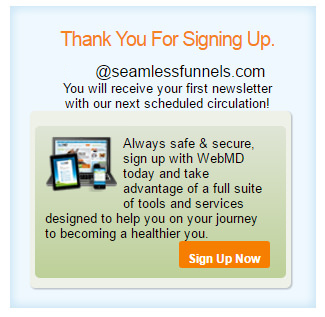Marketing Funnel Example Step-by-Step
You’re about to step into WebMD’s marketing funnel, which along with its web properties have earned authority through the years to become one of the most trusted health web brands.
Listed as the second most important health website by Alexa, but stands as the number one performer in organic health search with more than 80 million organic visitors per month according to SEMrush.

Let’s dive right into it, and discover a few strategies to improve your marketing funnel.
Understanding WebMD’s marketing funnel
According to SimilarWeb, WebMD’s traffic mainly comes from organic sources.
Browsers begin their journey into the marketing funnel by searching online for informational health queries like symptoms, causes, prevention, diagnosis, treatments and other topics related to a certain condition.
Traffic source breakdown: 80.03% of traffic coming from search engines.
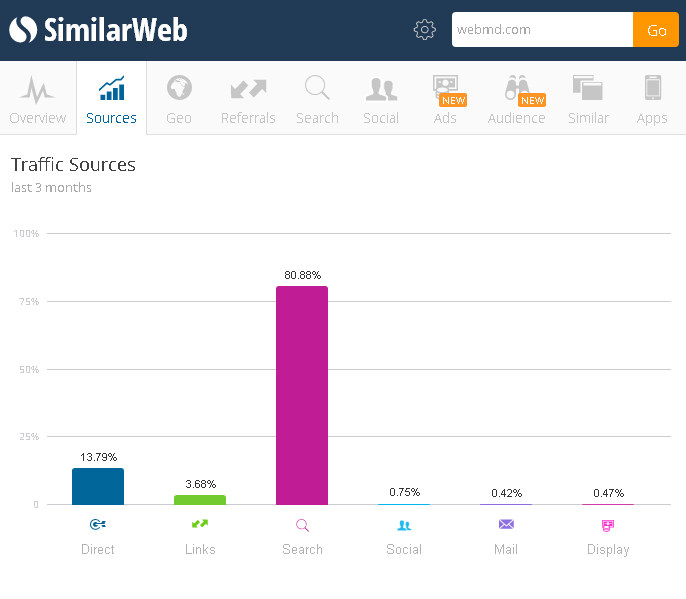
Alexa reports that 52% of WebMD’s organic traffic comes from Google.

The consumer buying process in the health funnel
Marketing funnel stages overview
Although most of the times you will only see marketing funnels analyzed from one perspective, seeing it from multiple angles can help.
Since WebMD’s marketing funnel ultimately lead to a advertisement. Advertisers should carefully analyze WebMD’s marketing funnel as it’s own funnel, separating the visitor’s needs from what the marketer want to expose new insights from this marketing funnel.
Funnel stages from the consumer’s point of view
Let’s analyze the stages of the funnel viewed from the consumer’s perspective.
The awareness stage
In this stage of the funnel a person will experience a trigger and become aware of the need.
It’s important to note that depending on the urgency of the need, which will vary according to how serious the condition and stage, consumers will go from the awareness stage of the funnel to the consideration or usage stages.
The discovery stage
At the discovery stage of the funnel a person will start searching for information online.
The evaluation stage
Browsers become visitors of a website and move into the middle of the funnel where the evaluation stage take place.
At the evaluation stage of the funnel visitors are going through the content trying to find answers.
If the visitors are continually interested in the topic at this point they subscribe to the newsletter to receive more information about the topic or to get some type of benefit.
The consideration stage
At the consideration stage visitors are determining the best options available. Either they need more information and will consider step back into the evaluation stage and researching other websites, asking for advice or seeing a doctor.
The usage stage
Visitors become costumers and use some type of treatment, medicine or product.
The advocacy or opposition stage
At the advocacy stage of the funnel consumers will either recommend and share good reviews or criticize and share bad reviews online.
The re-usage stage
If consumers are satisfied with the end result they will move into the re-usage or re-purchase stage of the funnel.
The loyalty stage
At last, in the loyalty stage consumers will re-purchase through the years when the need arrives depending on the type of disease and condition.
Funnel stages from the marketer’s point of view
Stages of the funnel viewed from the marketer’s prospective.
The awareness stage
In this stage of the funnel content organically ranked in search engines bring visitors to specific topic pages.
The engagement stage
This is where content provides value by answering the visitor’s questions and start building trust to take visitors to the lead acquisition stage.
The lead acquisition stage
At this stage of the funnel visitors are offered to become subscribers with the incentive to get more content on a specific health topic on a weekly or daily basis.
The lead nurture or email marketing stage
Lastly visitors become subscribers or readers where they get exposed to more content and advertising over and over again. At this stage of the funnel they may also start following profiles on social media and participating in one of the WebMD’s communities.
The purchase stage
At this stage visitors will click on ads throughout the journey or in the newsletter.
WebMD funnel strategy
The strategy behind this content marketing funnel is to bring as many organic visitors as possible, creating awareness of the brand, building trust by publishing high-quality content, and converting them into subscribers to repeatedly advertise to them through email marketing.
WebMD’s content strategy
With a very rich content marketing calendar, WebMD publishes content in general health, conditions, food, nutrition, beauty, fitness, exercise, pet, family and parenting categories.
Funnel Example
Let’s just use “pneumonia” as an example, which is according to alexa a query that leads 0.38% of its massive traffic to WebMD.
Google keyword planner shows around 550,000 searches for “pneumonia” per month.
First step in the organic funnel
WebMD ranks number one for the query with the pneumonia topic overview page which provides an overview of the topic plus links to other pages with further reading including symptoms, causes, prevention, medications, treatments, health-tools and other related information about pneumonia.
Funnel check point
Unconscious though sequence at this stage of the funnel
As we land on the topic overview page.
- Where am I?
- What can I do here?
- Why should I trust WebMD?
At this stage of the funnel, is the content matching the searcher’s intent and expectations?
This may depend on the specific condition. From the awareness stage of the funnel to consideration and decision, the pneumonia topic overview page has a vast range of links to cover every subtopic, so certainly this information would be very useful and match the searcher’s intent wherever they may be in the funnel.
Why should I trust the content?
Trusting the content is key! That rule applies to all websites, but when it comes to your health or of a loved one, it becomes critical!
In this case WebMD did provide reference at the end to the Physician who reviewed the article.
It’s important to note that the evaluation will become more rigorous depending on the condition and stage of the disease. Placing credentials with as much information as possible is highly recommended.
Lead acquisition strategy
Moving from front end acquisition to back end marketing
WebMD has a very basic lead acquisition strategy. A simple popup is displayed as you scroll down offering visitors to get daily health tips and wellness updates.
The second lead acquisition is below the fold at the bottom right and it allows you to select topics of interest.
Observations about the lead gen box
- Lack of benefits reducing the value perceived by the reader.
- By offering select topics WebMD increases the reader’s interest but also reveals that the list is segmented by topic.
Segmenting the list if a good way to improve open rates since anyone would rather receive articles and information related to their interest rather than non-relevant random information.1
Moving From Front to Back End Marketing
Let’s just say I am interested in getting more information, so I select COPD and hit subscribe.
Now I’m presented with the thank you popup with an offer.
Observations
- It’s great to know that you will be getting the newsletter with the next scheduled circulation but it’s not specific enough, which then makes the reader guess the exact schedule and therefore take a bigger chance in losing interest.
- They offer the option to sign up to take advantage of tools and services, but they failed to provide benefits or advantages of using them.
- There is no value perceived by the call to action.
Email marketing and lead nurture funnel stage
The content marketing machine
WebMD emailed from July 2015 to May 2016 twenty to sixty articles.
How many times a month they email content?
Here’s the average amount of articles published and/or emailed to WebMD’s Lists.
- 20 articles – Jul 2015
- 24 articles – Aug 2015
- 23 articles – Sept 2015
- 26 articles – Oct 2015
- 32 articles – Nov 2015
- 33 articles – Dec 2015
- 33 articles – Jan 2016 – including happy birthday email
- 47 articles – Feb 2016
- 46 articles – March 2016
- 49 articles – April 2016
- 60 articles – May 2016
How long is the copy?
The topic overview page WebMD has 2098 words. But most articles are between 1000 to 2500 words.
How big is the WebMD’s website?
By using the site operator we can see the magnitude of WebMD’s organic marketing funnel. I actually had to count it twice to make sure it was right. Above 10 million results. Yes that’s right!
How old is the WebMD website?
14 plus years.
Takeaways
Content Architecture
Why is it important to understand the content structure?
Google’s AI (artificial intelligence) technology called “rank brain” learns on it’s own, which means it must utilize the current knowledge or the index to make comparisons with trusted websites, which means if the most trusted websites have content structured a certain way and talk about certain topics as well as link to certain websites, you should consider researching the topics and how they are linked, and most importantly understand the semantic relationships between topics in a niche.
To analyze semantic relationships and discover gaps in your content you can use tools like Rank-Tracker or SEMrush.
Content
Produce high quality content that answers the visitor’s thought sequence and include evidentials to validate your content and reduce friction. Check Google analytics and improve pages that have high bounce rate.
Consider creating topic overview pages.
Lead Acquisition
Focus on the value perceived in exchange for the click. If the value perceived is much greater than acquiring emails will be easy.
Up Sells
Clarity will trump persuasion.
Back End Marketing
- Communicate as often as possible with your list and always provide as much value as possible so you can build an authoritative and lasting relationship.
Other Big Health Websites
According to Moz’s Open Site Explorer it’s domain authority is 95/100, which compares to other top health websites currently ranking for the most searched health queries.
Starting at the broadest term online “health”, we narrowed down to the categories to find out what are the most trusted health websites.
- Forbes Health with 97/100.
- Health.com with 86/100
- CNN Health with 98/100
- Wikipedia 100/100
So now I’m Curious…
Speaking of “Marketing Funnels” (wink wink)…
- How are YOU using funnels in your business?
- Which of these marketing funnel strategies are you going to take action on next?
- Have you tested or implemented these funnel strategies and gotten better results?
It would mean the world to me if you share your results and stories in the comments below…I can’t wait to hear from you!
References
1https://mailchimp.com/resources/research/effects-of-list-segmentation-on-email-marketing-stats/
2Designed by Freepik

